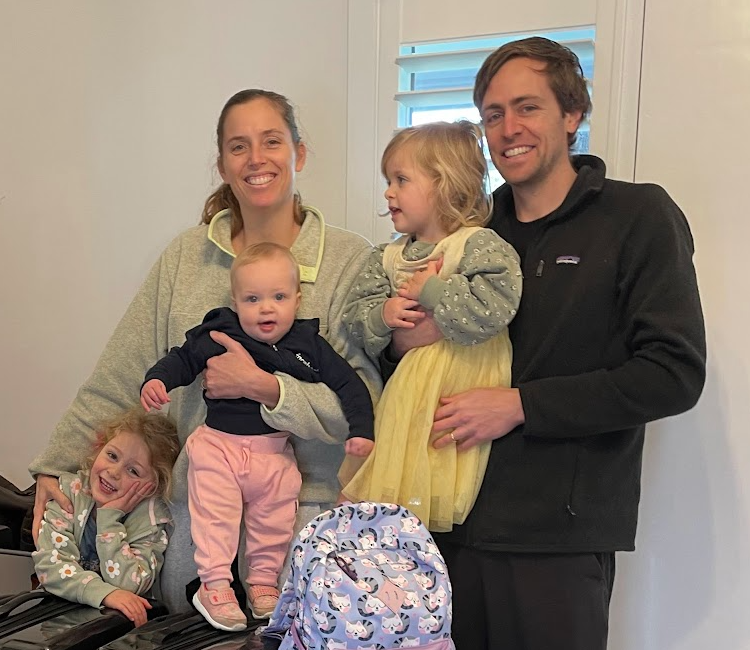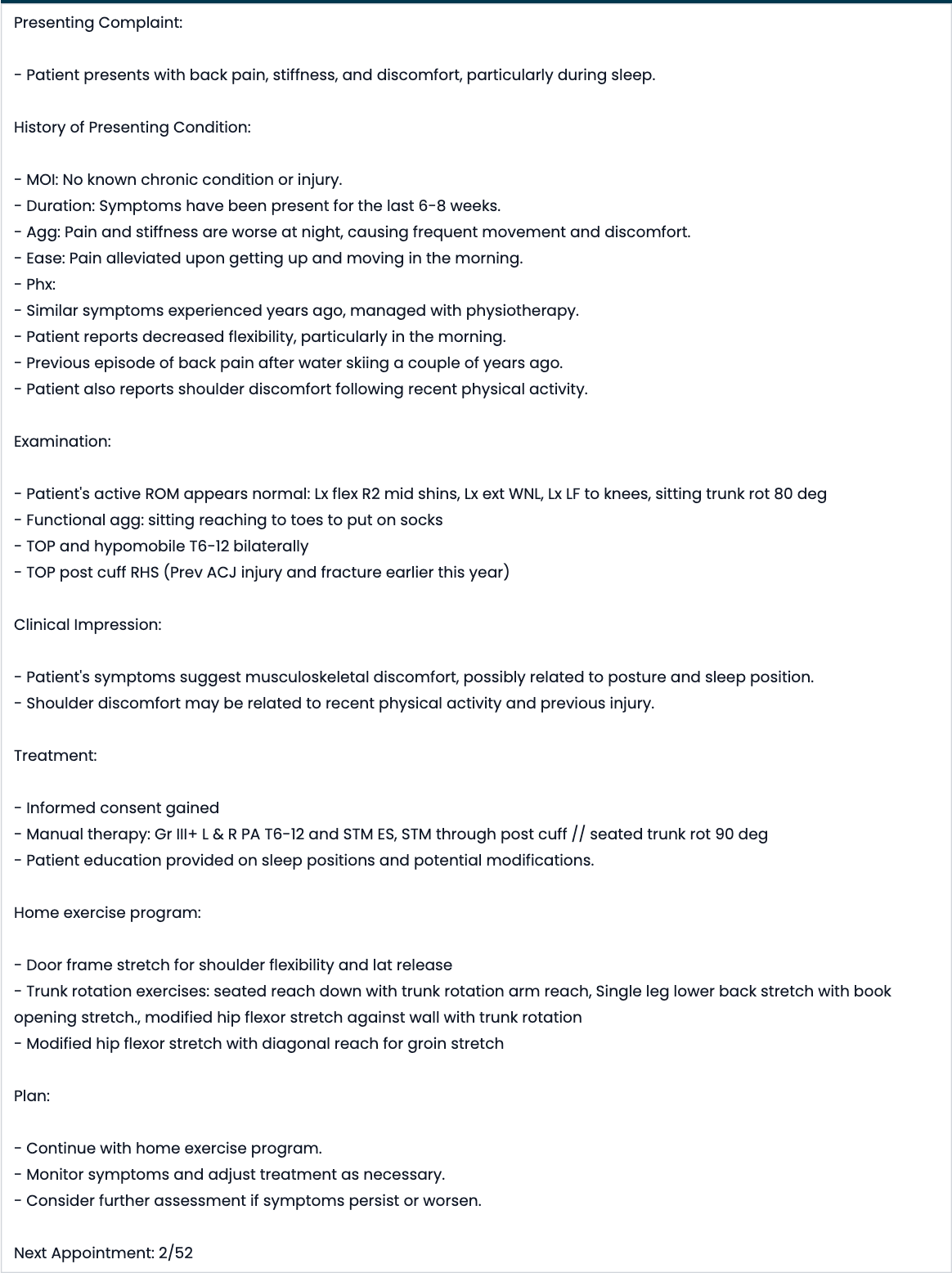How AI has made me a better Physiotherapist
This year I have radically changed the way I work. The way I communicate with my patients has dramatically evolved and improved. And I’m enjoying my work more because of it.
What did I change? Well. Come on a journey with me as I reflect on my resistance, shaping, and embrace of a new technology.
A little personal update
In 2021 I relocated from San Francisco to Melbourne, Australia with my husband (Jason) and two young daughters. I’m now a mum of a 1, 3 and 5 year old. But, I am still a Physio too. I am thrilled to be practicing Musculoskeletal Physiotherapy at my original workplace, a fabulous private practice called Physica, who welcomed me back and provided the flexibility to continue prioritizing motherhood.
I returned to work 6 months after my third child was born. Starting with a single Saturday morning 4-hour shift. It was a reach for both of us as I was still exclusively breastfeeding. 4-hours stretched into 5 or 6 hours with travel, admin, and giving patients a little extra time. I felt the pressure building up (literally).
Jason is a software engineer who is deeply passionate about user experience, infrastructure, reliability and security. He was the reason I moved to San Francisco as he pursued his career at Zendesk. Now he was at home with the kids feeling the same feelings I had often felt: “I thought she was finishing at 1pm? I wonder when she’ll be home?”.
I’d often be 30-60 minutes late getting home finishing documentation or writing a referral letter. High quality documentation is something I feel passionate about, yet, it often falls outside of work hours. This is reflective of my practice style, I struggle to type it all within the session as I’d prefer to use every minute as direct patient care. I also have little care for protocols or pre-written exercise programs. Each patient is a unique individual who I believe requires a comprehensive and individualized assessment and bespoke treatment plan. What this means is a lot of writing.
An idea was born
And so began a discussion between Jason and myself:
Jason “What if we can create a program that writes the clinical notes for you?”
Sian “I don’t think so. How?”
Jason “Using AI”
Sian “I’ve been told specifically not to use ChatGPT or AI at work.”
Jason “AI systems can be built to be safe to use in healthcare”
Sian “I don’t know…”
Questions start circling through my head. I was nervous of using AI technology that other colleges were emphatically warning against using it. Despite my nerves and reservations, I could tell Jason was excited. And, I should know by now that my caution towards new technology is exactly the response that releases his relentless positive motivation.
The next night Jason showed me an example using a demo patient interview he found online:
Jason: “Would you say this is a normal physio consult?”
Sian: “Yes”
Jason: “And how are these clinical notes?” (generated from the video)
Sian: “Not that good”
Jason: “Ok. How would you write them?”
This went on for a few nights. And then he had an app, working, that actually was half-reasonable. And who did we try it on first? Jane.
Jane is our 3-year-old. And she loves playing doctors and nurses. Jane presented with her baby who had fallen off her bike while not wearing a helmet. She was also concerningly feeding her baby cat food. The app did an incredible job summarizing the main problems and the doctor's treatment plan.
The next Saturday morning I took the leap and tried out at work. I was nervous. My first patient came in and I asked for consent to record our conversation. They were totally fine with it. But the results were OK. Not perfect. Just OK.
Fast forward to today, and I won’t work without PatientNotes assisting me. PatientNotes has basically removed the burden of administration from my job. PatientNotes works by recording the audio of a consultation and within 30 seconds of finishing my consultation a draft of my clinical notes are written for me in my own personal style. Then PatientNotes uses these clinical notes to write a Patient Summary that I email to them. My clients love these summaries and now nearly demand them. Throughout my career I have tried many methods on communicating exercises/treatment plans/education to patients. Paper notes, stick figures, online exercise software and this is the first time my patient’s have deeply appreciated the content.
But I’m not here to convince you to try it out. The reason for sharing this blog is that I wanted to share how AI can assist us in this area of documentation and reflect on my willingness to adopt new technology.
Early stages of Patient Notes
While trying out the software I certainly went through the Kubler-Ross change curve stages. But for this blog I’ll classify the stages as the following:
Phase 1: I shouldn’t have to write anything. It’s replacing me.
Phase 2: Customize it to write the ultimate clinical notes, perfectly.
Phase 3: My assistant who does 95% of the work and I complete the rest.
Phase 1
At first I had the expectation that it is possible to use AI to generate complete notes. My mind set was that if I spoke it out-loud, then it was possible it would be written. I described every test and treatment in detail. In doing so I gave the patient extra context about my clinical reasoning that is often just thought and not said.
My patients definitely appreciated the extra context and more direct conversation. But at the end of the conversation I was deflated. I expected a perfect summary. Instead, I was speaking so much that I broke the initial version of the app (more than a few times). And when it broke, I’d be frustrated because I didn’t write anything and had to start from scratch the old way but now all outside work hours. Jason definitely got a piece of my mind about this new idea. Did it deter him? Not at all. This was exactly the feedback that creates the most powerful change.
Phase 2
PatientNotes allows you to completely customize the notes that get generated. They have the concept of “prompts” that are guiding the large language models to produce the drafts for you. What’s cool about this is you can completely customize them allowing you to change the structure or content of the notes that get generated.
I entered this phase with a drive towards perfection. I decided to trawl through text books and lectures and build a prompt that was incredibly detailed. The ultimate musculoskeletal and women’s health assessment. Each term had a definition associated with it. In my mind I thought I could generate the most perfect notes and I spent hours refining prompts.
Ultimately, it was too much. If the transcript didn’t contain relevant information, the app got confused trying to fill in information into each section. As clinicians we often omit certain sections that aren’t relevant, and this confused the app. How interesting to learn that AI in its current form doesn’t respond well to incredibly detailed and verbose templates.
So I expanded the prompt set to the maximum, shrunk it down to the minimum and found the ideal in between. The default prompts offered for Physiotherapists who sign up today take all of my exploration during this phase into consideration.
Phase 3
After months of testing PatientNotes, I have arrived at Phase 3. I know what to expect, I know which parts are the conversation are captured best and I know where to spend time editing and completing the draft notes.
I don’t speak out loud for everything anymore. My workflow is:
Patient comes in and I ask for consent to record our conversation.
I start recording.
Sometimes I type a few notes that I want phrased in a specific way. Sometimes I document a few test measures and sometimes I just record and work without touching the computer.
I pause the recording after the consultation is finished and walk the patient out.
Then, I either end the recording or I spend a moment summarizing information that I didn’t say during the session.
Then I click end recording.
My clinical notes are generated with 95% accuracy. I refine them and mark them as complete.
Then a patient summary is generated that I review and email to the patient.
I go and get my next patient.
For follow up consultations I sometimes don’t record the session, rather opting to manually write my clinical notes based on a prior session. But I still write them in PatientNotes (manual entry) so a summary letter can be generated.
When required, I also use the same clinical notes to generate Medical letters, Referral letters, intra-clinic letters. PatientNotes offers a variety of letter structures based on inbuilt prompting.
So what did I change that made my work so much more enjoyable?
After adopting this new technology, I am now able to maintain more eye contact with patients. I believe this leads to better patient-therapist rapport and a more natural flow of conversation. This definitely has the most impact during my initial consultations.
Every patient receives a summary of their consultation via email or letter. I have experienced better compliance with home exercise programs, less confusion or questions about treatment plan, and a more active engagement in their recovery.
As a result, my work is much more enjoyable. The work is done, within my hours. I can now be fully booked and not run late, run overtime or need to block out admin for letter writing.
And the most important change for my life - I make it home on time, every day, to be with Jason and my little girls, ready to jump straight back into parenthood again.
Sian
If you’d like to try PatientNotes yourself, you can sign up for a free trial here: https://www.patientnotes.app
And if you are attending the APA Physiotherapy Conference next week in Brisbane, there are going to be a great group of folks at the launch party. Here is the link to register: https://www.patientnotes.app/events/launch
The Patient Notes Team





